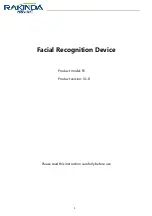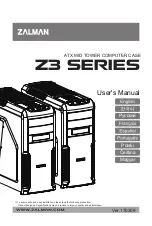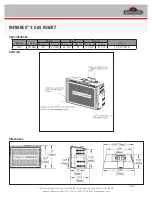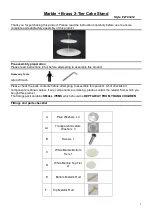
CAREL Industries HQs
Via dell’Industria, 11 - 35020 Brugine - Padova (Italy)
Tel. (+39) 0499716611 – Fax (+39) 0499716600 – www.carel.com – e-mail: [email protected]
+050001038 - rel. 1.0 - 18/05/2017
Caratteristiche tecniche
Interfacce
Porta Seriale (*)
RS485 max 115 Kbs; Connettore
sconnettibile a vite passo 5,08
Rete 2G/3G:
Hepta-band 850/900/AWS
1700/1900/2100 MHz
(*) Nota: la porta seriale non è di tipo TNV.
Funzionalità
Protocolli Modbus
RTU / Modbus
over pLAN
Numero max controlli
10
Buzzer
Segnala lo stato della rete 2G/3G
Ratings
Alimentazione
24 Vrms -15÷10% 50Hz Max 0.5 Amp
rms (14VA)
12 to 30 Vdc ±5% Max 0.4 Adc a 12Vdc
Potenza max assorbita
6 W
Fusibile
Automatico
Peso
Approx 1 kg
Batteria
Non ricaricabile al litio mod BR2330
Classe e struttura
software
A
Resistenza al calore e
al fuoco
Cat. D
Immunità contro le
sovratensioni
Cat.II
Classe isolamento
Classe III
Condizioni ambientali
Temperatura di lavoro
-20 to 60 °C
Temperatura di
immagazzinamento
-20 to +70 °C
Umidità di lavoro e
immagazzinamento
5 to 85 % umidità relativa,
non-condensante
Grado di inquinamento Grado II
Technical specifi cations
Interfaces
Serial port (*)
RS485 max 115 Kbs
Screw connector, pitch 5.08
2G/3G network:
Hepta-band 850/900/AWS
1700/1900/2100 MHz
(*) Note: the serial port is not for TNV lines.
Functions
Protocols Modbus
RTU / Modbus
over pLAN
Max no. of controllers
10
Buzzer
Signals 2G/3G network status
Ratings
Power supply
24 Vrms -15-10% 50 Hz Max 0.5 Amp
rms (14VA)
12 to 30 Vdc ±5% Max 0.4 Adc at 12 Vdc
Max power consump.
6 W
Fuse
Automatic
Weight
Approx 1 kg
Battery
Non-rechargeable lithium, mod.BR2330
Software class and
structure
A
Resistance to heat
and fi re
Cat. D
Immunity against
voltage surges
Cat.II
Insulation class
Class III
Environmental Conditions
Operating temperature -20 to 60 °C
Storage temperature
-20 to +70 °C
Operating and storage
humidity
5 to 85 % relative humidity,
non-condensing
Environmental pollution type II
Collegamento elettrico e Rete RS485 /
Power and RS485 network connection:
1
Porta 485 /
485 Port
2
Antenna 2G/3G /
2G/3G antenna
3
Alimentazione /
Power supply
Seguire gli schemi indicati utilizzando cavo schermato
per reti RS485 /
Follow the diagrams shown, use
shielded cables:
Per il collegamento al pCO seguire i colori indicati in
fi gura /
To connect the pCO follow the colours indicated
in the fi gure:
3
2
1
Fig. 4
NON collegare le resistenze di terminazione da 120
sul primo e sull’ultimo dispositivo della rete in quanto
la porta Rs485 è di tipo HW slave, il numero massimo
di dispositivi collegabili nella rete è 10 e la lunghezza
massima della rete è 500m. /
DO NOT connect the
120
terminal resistors into the fi rst and the last
devices of the Rs485 network, this is because the Rs485
port is HW Slave type. The maximum number of devices
which can be connected in the network is 10, and the
maximum lenght of it is 500 meters.
CAREL reserves the right to modify the features of its products without prior notice.
Schema per collegamento a pCO5 /
Connection to pCO5
230 Vac
24 Vac
L N
230 Vac
24 Vac
L N
230 Vac
24 Vac
L N
J26FBus2
J25 BMS2
J11 pLAN
pCO5
G
G0
J26FBus2
J25 BMS2
J11 pLAN
pCO5
G
G0
J26FBus2
J25 BMS2
J11 pLAN
pCO5
G
G0
collegare a terra / connect to earth
Fig. 7
J26FBus2
J25 BMS2
J11 pLAN
pCO5
G
G0
J26FBus2
J25 BMS2
J11 pLAN
pCO5
G
G0
J26FBus2
J25 BMS2
J11 pLAN
pCO5
G
G0
Power supply
collegare a terra / connect to earth
Fig. 8
GND
+
coppia intrecciata /
collegare a terra /
interfaced couple
G0/- G/+
Fig. 5
RS485 shielded twisted pair cable
G G
0
G
G
0
G
G
0
or if no pCO
present
G
G
0
12...30 Vdc
+
-
24 Vac
230 Vac
* Leggere le avvertenze
per il collegamento /
Read
warnings for connection
To other device: max cable length 500m, max device 32
Fig. 6
Avvertenze per il collegamento elettrico
Utilizzare un trasformatore di sicurezza o un alimentatore con avvolgimenti
separati che assicuri un isolamento equivalente come stabilito nelle IEC
61558-2-6 e IEC 61558-2-17 e collegare la carcassa metallica del dispositivo e
la linea G0 a terra (collegamento funzionale). In caso di unico trasformatore
di alimentazione tra il dispositivo il relativo controllo, si raccomanda di non
invertire le connessioni G0 e G sui morsetti di alimentazione per evitare danni
ai dispositivi.Utilizzare un dispositivo di interruzione dell’alimentazione come
protezione in caso di guasto (per il dimensionamento vedere i dati nominali
riportati su “Ratings” nella tabella “Specifi che tecniche”).
Warnings for electrical connection
Use a safety transformer or power supply with separate windings that ensures
equivalent insulation as established by IEC 61558-2-6 and IEC 61558-2-17, and
earth the device’s metal casing and G0 line (functional connection). If the same
power transformer is used for the device and the corresponding controller,
do not reverse the G0 and G connections on the power terminals to avoid
damaging the devices.Use a power disconnect device as fault protection (to
size the device see the rated data shown under “Ratings” in the “Technical
specifi cations”).
This device complies with part 15 of the FCC Rules. Operation is subject to the following two conditions:
1. this device may not cause harmful interference, and
2. this device must accept any interference received, including interference that may cause undesired operation.
Changes or modifi cations not expressly approved by the party responsible for compliance could void the user’s
authority to operate the equipment. This equipment has been tested and found to comply with the limits for a Class B
digital device, pursuant to part 15 of the FCC Rules. These limits are designed to provide reasonable protection against
harmful interference in a residential installation. This equipment generates, uses and can radiate radio frequency
energy and, if not installed and used in accordance with the instructions, may cause harmful interference to radio
communications. However, there is no guarantee that interference will not occur in a particular installation. If this
equipment does cause harmful interference to radio or television reception, which can be determined by turning
the equipment off and on, the user is encouraged to try to correct the interference by one or more of the following
measures:
1: Reorient or relocate the receiving antenna.
2: Increase the separation between the equipment and receiver.
3: Connect the equipment into an outlet on a circuit diff erent from that to which the receiver is connected.4: Consult
the dealer or an experienced radio/TV technician for help.




















